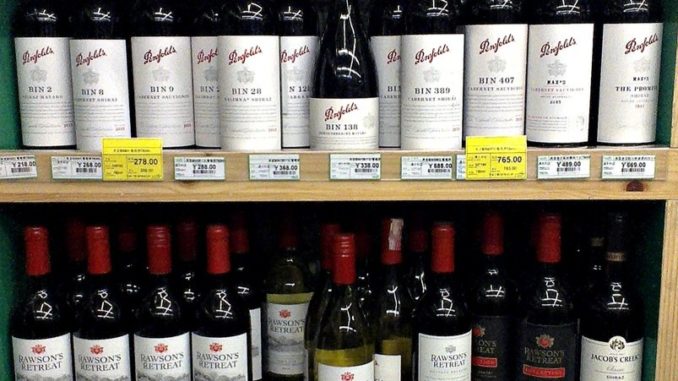
News of China dropping its Australian barley tariffs is raising hopes that Australian wine will be next in line. From the Australian Financial Review:
“China has agreed to lift tariffs on imports of Australian barley from Saturday in a key concession to more than $20 billion worth of sanctions on exports imposed at the height of political tensions between Canberra and Beijing.
(Full story here)
China’s Commerce Ministry said in a statement on Friday it had advised the government’s Customs Tariff Commission to remove anti-dumping and countervailing duties on barley imports from August 5.”
Australia was pretty much pushed out of China’s wine market going on three years ago due to tariffs as high as 218 percent, the result of an anti-dumping investigation by China.
The case was initiated by China Alcoholic Drinks Association (CADA), cited as having 122 wine producers that represented the “vast majority of total [China] output.”
The argument: “A large amount of Australian wine has been exported to the Chinese market in recent years, which has caused serious impact and damage to the domestic wine industry.”
Ten companies were targetted, including Treasury Wine Estates (TWE), which, with its Penfolds label, had a huge slice of Australian imports. Others listed included Casella, Accolade and Australian Vintage. (See here.)
Peak Australia
The case and tariffs came at a time of Peak Australia.
Customs data for the first six months of 2020 showed Australian bottled wine had a 38.2% share by value versus 26.3% for France and 13.1% for Chile. Italy and Spain were lengths behind at 6.7% and 6%.
Australia led by volume, too, though the race was tight here, at 25.1% versus 22.2% for France and 20.9% for Chile. Spain had 9.8% while Argentina was at 8.3% and Italy at 6%.
With value share far higher than volume share, Australia naturally had the top value per liter of any major source, with US$5.9 versus US$4.6 for France and US$4.3 for Italy. Far behind were Chile at US$2.4, Spain at $2.3 and Argentina at–what!?–US$0.8.
(In 2013, Australia had just 12% of the market by volume and 17% by value.)
Anyway you measure it, Australia was number one when the case was initiated. And in the case of TWE, and Penfolds, their value was comparable to entire nations. See: If Penfolds were a country, where would it rank?)
Post-tariff decline
Since the tariffs, Australian wine imports plummeted, and the Wine Australia office closed, although the presence of Australian wine in online and offline retail persisted and suggested there was ample stock in the market.
A hoped-for boon for Australia’s competitors, including local brands, did not materialize–overall imports continue to steadily fall as has local production, despite major investment and government support, and this has all led to a great deal of handwringing.
During this era, TWE–which saw its shares rise 3 percent today–kept a toehold in China, including via a “long-term, multi-faceted strategic co-operation agreement” with CADA, the very organization that spearheaded the tariffs, in areas such as “technical knowledge and expertise exchange in China wine region development, programs to champion wine education and wine culture, and brand support for the development of world-class quality, integrity, and valuation systems for Chinese grapes and wine.”
TWE also made several wines in China, including one released last month in Yunnan.
Tariff Legacy
That seemed like a lot of effort to maintain a sliver of a former presence but hopes have always been high in China given the potential sales in this billion-person market.
Anyway, as tariffs on various goods are lifted, and we await the fate of those on wine, it will be interesting to see the legacy.
Predictions that Australia would quickly capitulate to China in the face of these tariffs were proven wrong as the country’s producers sought, and in many cases, found alternative markets for their goods. And there will no doubt be hesitancy to rely too much on the China market again given that such tariffs could happen again.
“… Australian exports also quickly found other markets and China’s power generators, seafood suppliers and manufacturers suffered from having to use lower quality and more expensive products.”
“The Productivity Commission said in July that the impact of China’s trade sanctions reduced the total value of Australian exports to the world by just 0.2 per cent as producers diversified their exports to other countries.”
According to Australia’s Foreign Minister Penny Wong, “barley producers have increased their exports to the rest of the world during this period from $400 million to $3 billion dollars, an increase of in excess of 600 per.”
Grape Wall has no sponsors of advertisers: if you find the content and projects like World Marselan Day worthwhile, please help cover the costs via PayPal, WeChat or Alipay.
Sign up for the free Grape Wall newsletter here. Follow Grape Wall on LinkedIn, Instagram, Facebook and Twitter. And contact Grape Wall via grapewallofchina (at) gmail.com.

Leave a Reply
You must be logged in to post a comment.